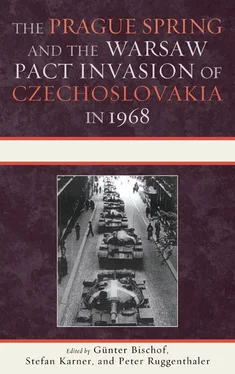The Čierná conference concluded on 1 August and was almost immediately followed by a general Warsaw Pact summit at Bratislava. Two days later, the only written statement to emerge from either of these conferences was produced. This was little more than a statement of alliance solidarity, combined with an affirmation of the principles of Marxism-Leninism. With this, the crisis seemed to be over. The Czech leadership apparently had mollified its Soviet and Warsaw Pact allies, at least for the time being. Dubček seemed to have won.
Not three weeks later, the Soviet Union invaded Czechoslovakia.
CIA military reporting closely paralleled Agency political analysis. As a member of the Warsaw Pact, Czechoslovakia was perforce under a fairly high level of routine surveillance. As tensions heightened over the spring and summer of 1968, so did the attention paid to Czechoslovakia by U.S. and NATO intelligence services.
The full panoply of sources available to Western intelligence included photo-reconnaissance satellites; covert intelligence collection performed by U.S. Air Force (USAF) aircraft transiting the Berlin traffic corridors, as well as by SR-71 reconnaissance aircraft along the inner German border, if required; SIGINT collection sites in southern Germany and on the Teufelsberg in occupied Berlin; and—particularly important during the Czech crisis—observations by the Allied military missions in East Germany. 35There also seems to have been some agent reporting available. 36
Military tension ratcheted up in the last half of March as the USSR concentrated troops along the Czech–East German border in the period leading up to the Warsaw Pact summit in Dresden. 37This was judged to be a prophylactic measure, but on 9 May, the CIA reported that Soviet troops in Poland had been seen south of Krakow moving in the direction of Czechoslovakia. 38Noting that the Soviets had a total of thirty-nine divisions available should they decide to intervene militarily, the CIA concluded, “It would appear that Moscow has decided to do some saber-rattling in order to influence the Czechoslovaks to put a brake on their democratization.” 39
The next month, the Soviet Union began a series of Pact-wide military exercises designed to mask the build up of forces against Czechoslovakia. These included
• Šumava or Böhmerwald: over 20–30 June, a command post and communications exercise involving Soviet, East German, Czech, and Polish troops in Czechoslovakia; 40
• Neman: from 23 July to 10 August, a rear-services exercise; and
• Skyshield: an air defense exercise, conducted over 11–20 August. 41
Of the three, Neman was regarded as the most ominous, since it involved recalling reservists, requisitioning transport from the civilian economy, and mobilizing forces from Latvia to Ukraine—measures which obviously could be designed to cover the mass movement of troops against Czechoslovakia. 42Nevertheless, although the CIA warned that these exercises could well be signs of military intervention, most analysts in the U.S. intelligence community continued to believe that the Soviet Union would exercise restraint. 43
The situation grew more ominous during July. Late in the month—just prior to the bilateral talks at Čierná nad Tisou—reports poured in of large troop movements in East Germany, southern Poland, and the parts of the USSR along the Czech border. 44On 22 July, the British Military Mission (BRIXMIS) reported that the Soviet 71st Artillery Brigade and 6th Motorized Rifle Division had vacated their barracks at Bernau, while the East German army barracks at Halle was empty. 45On 26 July, the CIA reported that the Polish government was under great pressure to prepare for an invasion. The Soviet 32nd Army in Poland had mobilized, as had a large number of forces in East Germany. Five Polish divisions in the Silesian Military District were at a high state of readiness. 46That same day, substantial elements of three East German divisions, including, most probably, the 7th Armored Division and the 11th Motorized Rifle Division (MRD) moved into restricted areas seventy-five miles south of Berlin. 47To find out more, USAF SR-71s flew along the inner German border, from where they could monitor developments up to 100 kilometers inside East Germany. Meanwhile, on 29 July, BRIXMIS saw the Soviet 19th MRD deploying from its barracks. 48
At the end of the month, most of the Soviet troops in Czechoslovakia were withdrawn, but they remained just outside the country, and Western observers noted that the route signs leading into Czechoslovakia for the military movements had been left in place. 49Four Soviet divisions in Hungary were reported moving into the field, roadblocks were set up, and convoys were seen moving in the direction of Czechoslovakia. 50On 31 July, the Soviet air force was detected making contingency preparations for operations in Czechoslovakia, while high-level military officials in Moscow were reported operating on an indefinite alert status. 51Three days later, the CIA’s Office of Strategic Research (OSR) warned, “It would appear the Soviet High Command has in about two weeks time completed military preparations sufficient for intervening in Czechoslovakia, if that is deemed necessary by the political leadership.” 52
Over the first three weeks of August, the CIA was forced to function without the support of its principal collection asset, photo-reconnaissance satellites. The film-return systems in use at the time lacked the flexibility to respond to the rapidly changing situation in Czechoslovakia. A KH-4B satellite was in orbit, but its canister was not recovered until after the invasion, and when it was, the film showed Soviet forces deployed to invade: airfields packed with aircraft and Soviet military vehicles painted with white crosses to distinguish them from identical Czech equipment. 53
By this point in time, however, overhead reconnaissance was not really necessary: there already was ample intelligence from other sources to show that, by the end of July, the Warsaw Pact was mobilized for an invasion of Czechoslovakia. The next two weeks or so were something of an anticlimax, for the simple reason that the Soviets themselves had not decided to intervene. This hesitation gave some reason to hope that an intervention was not forthcoming, but, with nearly forty Soviet divisions on the move, it was clear that the Soviet alert was continuing. 54When, on 18 August, the Soviets did decide to intervene, it was announced by SIGINT reporting of a Soviet military communications blackout all over Central Europe. 55
Two days later, on the morning of the invasion, Director of Central Intelligence Richard M. Helms met with the Bruce Clarke, the director of Strategic Research, and Richard Lehman, the director of Current Intelligence. Lehman relayed a wire service report that Soviet leaders had been summoned to Moscow for an urgent Politburo meeting—which, in fact, had occurred on 18 August. This was unusual in itself: Soviet leaders normally spent August entrenched in their dachas, and only a crisis would serve to get them out. Clarke, Lehman, and Helms agreed that, taken together with the military alert in Central Europe, the emergency Politburo meeting was a sure indicator something was about to happen, most probably the invasion of Czechoslovakia. Helms was already scheduled to meet with President Lyndon B. Johnson and decided to convey the information personally. Remarkably, Johnson rejected that conclusion, saying, “Dick, that Moscow meeting is to talk about us.” What Johnson knew, and Helms did not, was that the Soviet Union and the United States were due to make a joint announcement on 21 August concerning the planned strategic arms limitation talks. Not unreasonably, but unfortunately, Johnson believed that to be the subject of the meeting in the Kremlin. 56
Читать дальше












